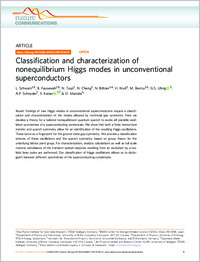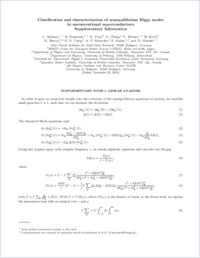Classification and characterization of nonequilibrium Higgs modes in unconventional superconductors
- Schwarz, L. Max Planck Institute for Solid State Research, 70569 Stuttgart, Germany -
- Fauseweh, B. Max Planck Institute for Solid State Research, 70569 Stuttgart, Germany -
- Tsuji, N. RIKEN Center for Emergent Matter Science (CEMS), Wako 351-0198, Japan
- Cheng, N. Department of Physics and Astronomy, University of British Columbia, Vancouver, Canada
- Bittner, Nikolaj Max Planck Institute for Solid State Research, 70569 Stuttgart, Germany - Department of Physics, University of Fribourg, Switzerland
- Krull, H. Lehrstuhl für Theoretische Physik I, Technische Universität Dortmund, Germany
- Berciu, M. Department of Physics and Astronomy, University of British Columbia, Vancouver, Canada - Quantum Matter Institute, University of British Columbia, Vancouver, Canada
- Uhrig, G.S. Lehrstuhl für Theoretische Physik I, Technische Universität Dortmund, Germany
- Schnyder, A.P. Max Planck Institute for Solid State Research, 70569 Stuttgart, Germany
- Kaiser, S. Max Planck Institute for Solid State Research, 70569 Stuttgart, Germany - 4th Physics Institute and Research Center SCoPE, University of Stuttgart, Germany
- Manske, D. Max Planck Institute for Solid State Research, 70569 Stuttgart, Germany
-
15.01.2020
Published in:
- Nature Communications. - 2020, vol. 11, no. 1, p. 1–9
English
Recent findings of new Higgs modes in unconventional superconductors require a classification and characterization of the modes allowed by nontrivial gap symmetry. Here we develop a theory for a tailored nonequilibrium quantum quench to excite all possible oscillation symmetries of a superconducting condensate. We show that both a finite momentum transfer and quench symmetry allow for an identification of the resulting Higgs oscillations. These serve as a fingerprint for the ground state gap symmetry. We provide a classification scheme of these oscillations and the quench symmetry based on group theory for the underlying lattice point group. For characterization, analytic calculations as well as full scale numeric simulations of the transient optical response resulting from an excitation by a realistic laser pulse are performed. Our classification of Higgs oscillations allows us to distinguish between different symmetries of the superconducting condensate.
- Faculty
- Faculté des sciences et de médecine
- Department
- Département de Physique
- Language
-
- English
- Classification
- Physics
- License
-
License undefined
- Identifiers
-
- RERO DOC 328172
- DOI 10.1038/s41467-019-13763-5
- Persistent URL
- https://folia.unifr.ch/unifr/documents/308470
Other files
Statistics
Document views: 136
File downloads:
- pdf: 341
- Supplementary material: 173

